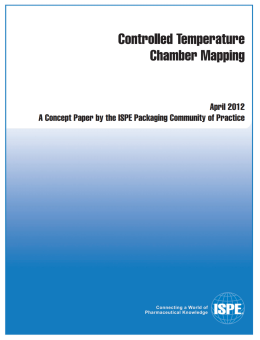Controlled Temperature Chamber Mapping

Downloads
1 Introduction
This document provides guidance on good practices for the mapping of controlled temperature chambers, warehouses, and refrigerated storage areas used to store raw material, work in progress, or finished product. It is intended to be used when specifying commissioning and qualification activities. The principles described in this document may be considered for controlled temperature chambers such as cold rooms, freezers, and warehouses. The approach is consistent with that described in the ISPE Good Practice Guide: Cold Chain Management [1], with examples provided that are more pertinent to a warehouse.
1.1 Key Terms
Commissioning
A well planned, documented, and managed engineering approach to the start-up and turnover of facilities, systems, and equipment to the end-user, that results in a safe and functional environment that meets established design requirements and stakeholder expectations [2].
Equipment Qualification (EQ)
Action of proving and documenting that equipment or ancillary systems are properly installed, work correctly, and actually lead to the expected results. Qualification is part of validation, but the individual qualification steps alone do not constitute process validation [3].
1.1.1 Risk-based Approach
With the advent of ASTM-E2500 “Standard Guide for Specification, Design, and Verification of Pharmaceutical and Biopharmaceutical Manufacturing Systems and Equipment” [4] may use a risk-based approach, with the equipment being verified; for further information see:
- The ISPE Good Practice Guide: Cold Chain Management [1]
- The ISPE Guide: Science and Risk-Based Approach for the Delivery of Facilities, Systems and Equipment [5]
There should be a clear definition of the acceptance criteria; typically this is provided in a User Requirement Specification (URS) or equivalent document.
Temperature mapping is used to confirm that the system is operating to meet specifications, i.e. the temperature range within the unit is acceptable.
It is a standard practice in the pharmaceutical industry to provide monitoring with an independent system; advantages of this practice include:
- Calibration of the monitoring sensors can be carried out without impacting the system operation
- The independent system becomes the “quality system of record”
- The data can be used to provide continuous verification of acceptable system performance
Mapping results may be used to define the number and location of monitoring sensors for a warehouse, cold room, or chamber.
2 When to Perform Temperature Mapping
Temperature mapping a warehouse should start as early as possible during commissioning and qualification. This allows the early detection and resolution of any performance issues. It also allows potential operational constraints to be identified and discussed with users, to determine if the constraints are acceptable or require resolution.
Systems that support the warehouse Heating, Ventilation, and Air Conditioning (HVAC) should be commissioned prior to temperature mapping of the warehouse, to help ensure complete and representative testing. Alternatively, the operating state of support systems should be understood to allow evaluation of sub-system operational issues that may affect test results. Sub-system operational issues should be monitored independently in case investigation is required, e.g.:
2.1 Prior to Temperature Mapping
Before temperature mapping commences, responsibilities should be defined (e.g., in a Commissioning Plan) and the following aspects should be considered:
- Scope of testing required
- Review and approval of test method statements
- Progress reporting
- Reporting and handling of test discrepancies
- Location and marking of mapping points
- Definition of the acceptance criteria/expected results1
- Witnessing requirements and notification procedures
- Handling/retention of raw data
- Format and content of the commissioning report (e.g., is a particular documentation practice required?)
Read more by downloading Controlled Temperature Chamber Mapping (Published: April 2012).